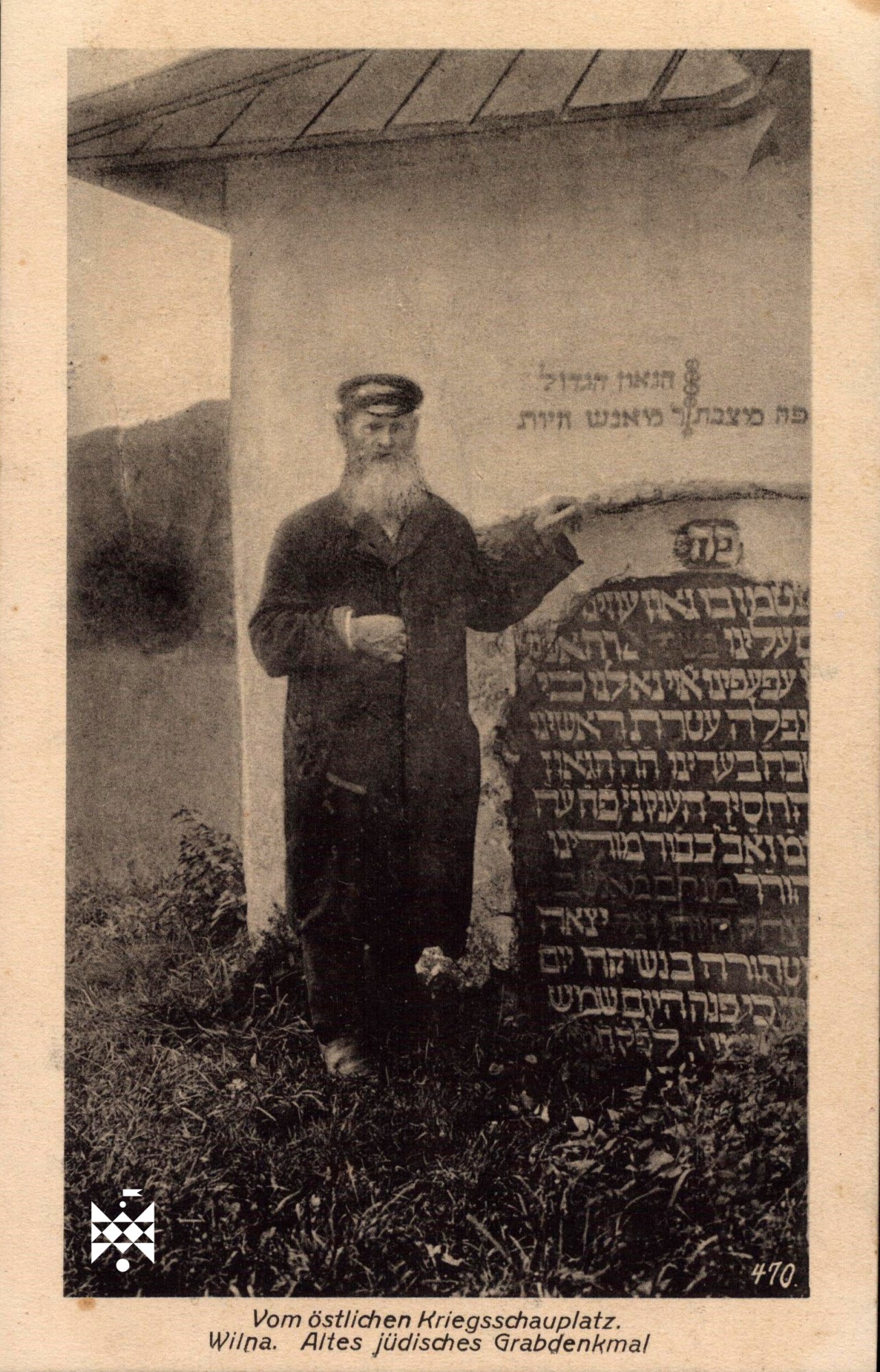Exhibit of the month |
← |
Published: 2023-06-30

Meir Yisrael Zelmanovich (1850–1920), caretaker of the Šnipiškės Jewish Cemetery,
at the tombstone and mausoleum of Rabbi Menachem Manes Chajes (1560–1636).
Postcard. Acc. No. VŽM 8060-3
The black and white photo of an elderly cemetery caretaker standing by the mausoleum and tombstone with an inscription in Hebrew was used for the postcard. Below the photo there is an inscription in German: Vom östlichen Kriegsschauplatz / Wilna. Altes jüdisches Grabdenkmal (‘From the Eastern Front. Vilnius, an old Jewish tombstone’). The reverse side of the postcard includes the publishing house data: Verlag Gebrüder Hochland, Königsberg i. Pr. (‘Brothers Hochlands, Königsberg, Prussia’). The photo was taken in Vilnius at the Šnipiškės Jewish Cemetery during World War I. The postcard was printed around 1916–1917 in Königsberg. German army soldiers were able to send home postcards from occupied Vilnius with various views of the city.
The Old Jewish Cemetery
The first Jewish cemetery of Vilnius was founded in the 15th century in Šnipiškės district (Shnipishok in Yiddish). The cemetery was closed for burials in 1831.
The Šnipiškės Jewish Cemetery became a place of pilgrimage. Thousands of Jews visited the graves of righteous and rabbis every year, including those of Ger Tzedek (Abraham ben Abraham, also known as Count Valentin Potocki (died in 1749), Vilna Gaon Eliyahu ben Shlomo Zalman (died in 1797) and Hayye Adam (Rabbi Abraham Danzig (died in 1820)). There were still visitors to this cemetery even after World War II.
Many famous rabbis were buried in mausoleums built in the old Jewish cemetery. A mausoleum is a solemn place of prayer for visitors to enter and pray. Tombstones were placed near the mausoleum and attached to their outer walls. Menachem Manes Chajes (1560–1636), one of the first Chief Rabbis of Vilnius, was buried in the mausoleum, which is visible behind the tombstone. On the wall of the mausoleum and above the monument of Menachem Manes Chajes, there is an inscription in Hebrew:
פה מצבת הגאון הגדול ר‘מאנש חיות
(‘Here is the tombstone of the great sage Rabbi Manes Chajes’).
The caretaker of the cemetery Meir Yisrael Zelmanovich (1850-1920) and his large family lived in a house on the territory of the cemetery. The family had ten children.
Unfortunately, almost nothing is known about the life of the caretaker. There is information only about his tragic death. Meir Yisrael Zelmanovich, the caretaker of the Šnipiškės Jewish cemetery, was killed during the pogrom in Vilnius on 10 October 1920.
In 1934, Meir Yisrael Zelmanovich' youngest son, Sholom Zelmanavich (born 1898, in Vilnius, died 1941 in Kaunas), a talented artist and playwright, published a book which included his play ‘Ger Tzedek. Count Potocki of Vilna’. The book was illustrated with his drawings and included images of the Šnipiškės Jewish cemetery.
Sholom Zelmanavich dedicated the book to his deceased parents.
Sources:
Shnayer Leiman, In Praise of Ephemera: A Picture Postcard from Vilna Reveals its Secrets More than One Hundred Years after its Original Publication (accessed via the Internet, accessed 2023-05-04: https://seforimblog.com/2020/07/in-praise-of-ephemera-a-picture-postcard-from-vilna-reveals-its-secrets-more-than-one-hundred-years-after-its-original-publication/
Prepared by Olga Movšovič, curator of the collection of photographs of VGMJH
© From the collections of VGMJH
| ↑ | ← |
